Toshiba 50L7300U Review: A 50-Inch LED HDTV With Wi-Fi
You've seen us dramatically increase our display coverage over the last year, and now we're reviewing HDTVs too. Our first screen is Toshiba’s 50-inch L7300U Cloud TV with Wi-Fi. We run it through our lab and usability tests to see how it measures up.
OSD Setup And Calibration
You’ll see from our photos that the 50L7300U, like a majority of HDTVs, has an extensive menu system offering many more calibration options than the average computer monitor. There are also plenty of settings for the set’s audio and network features.
We’ll go screen by screen to show you what makes this display tick. The moire pattern in the photos is not visible to the naked eye. Apparently, there is something in the screen's anti-glare layer that interacts with our camera.
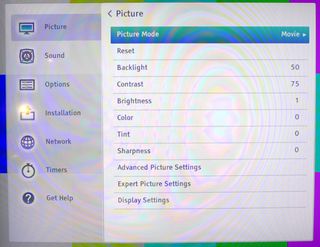
Pressing the Setup button on the remote brings up a menu tree typical of most modern HDTVs. The categories are on the left side and specific settings are on the right. The first screen, Picture, has everything you need for a thorough and precise calibration. There are six picture modes and all have different purposes. The default is AutoView, which uses a built-in light sensor to manipulate various image parameters based on ambient conditions and picture content. Dynamic is the expected torch mode; it's extremely bright and defaults to a very cool color temp and oversaturated color gamut. Standard is fully adjustable, but uses an oversaturated color gamut. The place to do your work is Movie, which is fairly accurate out of the box and can be calibrated to a very high standard. For gaming, choose Game. That mode eliminates extraneous video processing and improves response time and input lag (we were able to confirm this in our tests). PC uses a linear gamma curve to optimize computer images.
After the picture modes, you can see separate controls for brightness, contrast, and backlight. Most LCD HDTVs have this feature and we like it. It’s much easier to set the proper light level and maximize contrast when you can adjust the backlight independent of the black level. Sharpness adds unneeded edge enhancement and is best set to zero.
The remaining image controls are in the Advanced and Expert menus.
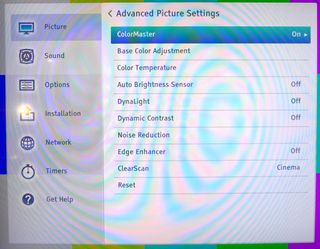
When you turn on ColorMaster, the CMS is unlocked. Although it won’t manipulate the color points well, it’s very effective at dialing in the luminance. The gamut in Movie mode is pretty good without adjustment, but it can be improved with an instrumented calibration. Color Temperature is simply three presets. The actual white balance sliders are in the Expert menu shown below. Auto Brightness Sensor modulates the backlight to match ambient lighting conditions. It’s best to leave it off. Dynamic Contrast and DynaLight work in concert to increase contrast by selectively dimming the backlight and altering the gamma based on image content. We experimented with them and you can see the results on page six. Finally, ClearScan is the frame interpolation algorithm. It has three levels plus Off. All options produce smoother motion, which some viewers prefer. Video purists will usually avoid this due to the “soap opera effect” it produces. If you leave it off, the TV will repeat frames to match the native 240 Hz refresh rate. When 24p content is received, it does a 10:10 pulldown that properly reproduces the original film-based content.
Here is the CMS.
Stay on the Cutting Edge
Join the experts who read Tom's Hardware for the inside track on enthusiast PC tech news — and have for over 25 years. We'll send breaking news and in-depth reviews of CPUs, GPUs, AI, maker hardware and more straight to your inbox.

It’s laid out correctly, but the saturation control acts more like a brightness (luminance) slider since it won’t alter the color points. Hue works well on the secondary colors. As you can see, we didn’t need to make large adjustments to render an accurate gamut.
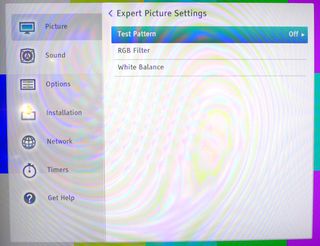
The Expert menu gives you a series of test patterns, and both two- and ten-point white balance controls. You’ll have to choose one or the other. We were able to achieve a decent grayscale with the two-point sliders, though the 10-point rewarded our efforts with near perfection.
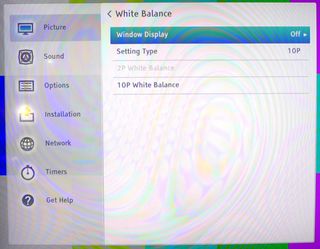
To set the 10-point white balance, you need to use the TV’s internal test patterns, which are accessed by turning on Window Display. Then you enter the 10P White Balance menu to adjust each brightness level individually.

While IRE is an older term for brightness level (it actually refers to an input voltage), it’s pretty much interchangeable with percent. There are red, green, and blue sliders for each level from 10 to 100 percent. We found that it’s best to work from the top-down when setting these controls. It’s a time-consuming process, but well worth the effort.
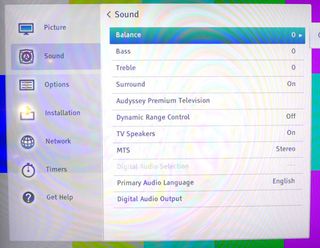
Audio from the 50L7300U is pretty good, considering the modest speakers. You can adjust the bass, treble, and balance, and utilize the Audyssey algorithms to simulate surround sound. Turning this on increases the sense of depth and spaciousness in the sound stage. If you want to use an external sound system, turn off the TV speakers altogether.
The remaining menus cover networking, which is very easy to set up thanks to built-in Wi-Fi, and convenience options like sleep timers, USB port settings, and the Bluetooth keyboard that comes in the package.
Calibration
Since this display is used in a different environment than most computer monitors, we’re doing things a little differently with regards to setting the maximum light output. However, all other standards for gamma, grayscale, and color remain the same. Our spec is Rec. 709/sRGB for the color gamut, D65 for the white point, and 2.2 for the gamma. For our tests, we calibrate the set for a day mode of 170 cd/m2 peak and a night mode of 120 cd/m2 peak.
We use the basic controls, along with the 10-point white balance and color management system, to make adjustments. The list of settings is long. However, if you want to get the most from the 50L7300U, they make a good baseline. The results are completely worth the effect if you have the gear to calibrate this TV yourself, though.
| Toshiba 50L7300U Calibration Settings | |||
|---|---|---|---|
| Picture Mode | Movie | ||
| Backlight | 50 Day, 35 Night | ||
| Contrast | 75 | ||
| Brightness | 1 | ||
| Color | 0 | ||
| Tint | 0 | ||
| Sharpness | 0 | ||
| ColorMaster | |||
| Color | Hue | Saturation | Brightness |
| Red | 0 | 0 | -2 |
| Green | 0 | 0 | -1 |
| Blue | 0 | -2 | 0 |
| Yellow | 3 | 0 | -1 |
| Magenta | 0 | 0 | 2 |
| Cyan | 0 | 0 | -1 |
| 10-point White Balance | |||
| IRE | Red | Green | Blue |
| 100 | -3 | 0 | 6 |
| 90 | 2 | 3 | 4 |
| 80 | -3 | 2 | -4 |
| 70 | -2 | 0 | 0 |
| 60 | -7 | -2 | 1 |
| 50 | -9 | -2 | 2 |
| 40 | -9 | 1 | -3 |
| 30 | 0 | 0 | 0 |
| 20 | 0 | 0 | 0 |
| 10 | 0 | 0 | 0 |
| Other Settings | |||
| DynaLight | Off | ||
| Dynamic Contrast | Off | ||
| Noise Reduction | All Off | ||
| ClearScan | Off |
Current page: OSD Setup And Calibration
Prev Page Toshiba 50L7300U Physical Characteristics Next Page The Toshiba 50L7300U In Use
Christian Eberle is a Contributing Editor for Tom's Hardware US. He's a veteran reviewer of A/V equipment, specializing in monitors. Christian began his obsession with tech when he built his first PC in 1991, a 286 running DOS 3.0 at a blazing 12MHz. In 2006, he undertook training from the Imaging Science Foundation in video calibration and testing and thus started a passion for precise imaging that persists to this day. He is also a professional musician with a degree from the New England Conservatory as a classical bassoonist which he used to good effect as a performer with the West Point Army Band from 1987 to 2013. He enjoys watching movies and listening to high-end audio in his custom-built home theater and can be seen riding trails near his home on a race-ready ICE VTX recumbent trike. Christian enjoys the endless summer in Florida where he lives with his wife and Chihuahua and plays with orchestras around the state.

Rare GeForce GTX 2070 engineering sample has surfaced — the unreleased GPU has 128 fewer CUDA cores than the RTX 2070

New firmware addresses Intel CPU gaming instability — Asus Intel Baseline Profile fixes crashing on Raptor Lake and Raptor Lake Refresh chips

Nvidia Blackwell and GeForce RTX 50-Series GPUs: Rumors, specifications, release dates, pricing, and everything we know
-
cats_Paw A bit expensive. Give me a good plasma 50-60 inch, low input lag, no smart, wifi... maybe 3d and usb play, but even that not necesary for a low price and im sold (like maybe LG 50PN6500, althou most reviews say its not too good).Leds are a bit more pricey at 50 inch >DReply -
iam2thecrowe Toshiba have always made good stuff, i had a toshiba tv a while ago and it had a better picture and more picture adjustments than anything else on the market at the time.I fully disagree with the above about a plasma, regardless of input lag or whatever, the picture quality is total garbage with all the speckles, all plasmas have it.Reply -
toddybody Love Toms...truly.BUTWhy are they reviewing a Ho-Hum 1080p TV from Toshiba? Seems more up CNET's alley to review blase consumer tech. Tom's is special for it's in depth and technical reviews of less heralded techie gear (i.e., CPU/GPU/HDD/Special Peripherals/Technical Prototypes...etc) What Im really trying to say is, Where is Half Life 3 and nVidia Maxwell? :DReply -
cangelini ReplyLove Toms...truly.BUTWhy are they reviewing a Ho-Hum 1080p TV from Toshiba? Seems more up CNET's alley to review blase consumer tech. Tom's is special for it's in depth and technical reviews of less heralded techie gear (i.e., CPU/GPU/HDD/Special Peripherals/Technical Prototypes...etc) What Im really trying to say is, Where is Half Life 3 and nVidia Maxwell? :D
Christian is writing Tom's Hardware-style display coverage for us, and doing a fantastic job applying the same deep-dive methodologies we use for other components to help quantify the strengths and weaknesses of monitors/TVs. Don't worry; you'll see us cover Maxwell when the embargo lifts on it ;) For Half-Life 3, you need to talk to Gabe. -
Nintendo Maniac 64 Toms, could you please confirm/deny if you actually tested that the Movie preset was the best and didn't just assume it was like many people do? While it doesn't sound like the TV model you tested has this specific issue, it's definitely something to keep in mind that the "Movie" preset may not always provide the best picture. I own a Toshiba 39L1350U and the Movie preset reduces the contrast and black levels considerably. To quote myself from the following post I made on AVS Forum:Reply
http://www.avsforum.com/t/1477874/toshiba-l1350u-series-2013/30#post_23923173
"Using the same settings on both Game and Movie, via OCD-levels of eye-balling I found that Game and/or PC modes (which look identical) have similar white levels with backlight @ 50 compared to Movie's backlight @ 68. By comparison Movie's backlight setting had to be set to 40 just to get black levels similar to Game and/or PC with backlight @ 50. And for reference,"Standard" seems to be about the same as Game and/or PC except that the backlight @ 42 seems to equal Game/PC's backlight @ 50."
For reference, CNET seemed to have assumed that the the "Movie" preset was the best when reviewing the L2300U (which is the same as the L1350U but in a different color) and then went and criticized the TV for having poor contrast and black levels. I just want to make sure Tom's doesn't make the same mistake in the future. -
ceberle Reply12613485 said:Toms, please do not just assume that the Movie preset is the best. I own a Toshiba 39L1350U and the Movie preset reduces the contrast and black levels considerably. To quote myself from the following AVS Forum thread post:
http://www.avsforum.com/t/1477874/toshiba-l1350u-series-2013/30#post_23923173
"Using the same settings on both Game and Movie, via OCD-levels of eye-balling I found that Game and/or PC modes (which look identical) have similar white levels with backlight @ 50 compared to Movie's backlight @ 68. By comparison Movie's backlight setting had to be set to 40 just to get black levels similar to Game and/or PC with backlight @ 50. And for reference,"Standard" seems to be about the same as Game and/or PC except that the backlight @ 42 seems to equal Game/PC's backlight @ 50."
This also means that your calibration settings are most likely incorrect for Game mode.
It's important to note that CNET made the same mistake by calibrating via the "Movie" preset when reviewing the L2300U (which is the same as the L1350U but in a different color) and then went and criticized the TV for having poor contrast and black levels.
We did not assume that Movie mode produced the best contrast, we measured every mode to determine which was the best starting point for calibration. Our black level measurements take into account the full rendering of detail down to the lowest brightness steps. It's easy to drop the brightness control and measure a better black level but detail will be crushed. In the game mode, we couldn't get any better black levels than movie when you take detail into account. Check out the article where we talk about the use of dynamic contrast. That will give you a pretty good idea where the balance is between contrast and detail. Remember also that Game mode does not have the accurate color gamut or flat grayscale and gamma tracking possible in Movie.
When referring to forum posts, a statement like "via OCD-levels of eye-balling" means that the writer is expressing an opinion, not facts arrived at by science. We suggest taking information like that with a grain of salt.
And yes, our calibration settings would be incorrect in Game mode.
-Christian-
-
Nintendo Maniac 64 ReplyWe did not assume that Movie mode produced the best contrast
Could you please read the edit I made to that post? I attempted to remove (or at least greatly reduce) any accusatory wording I may have used.
When referring to forum posts, a statement like "via OCD-levels of eye-balling" means that the writer is expressing an opinion, not facts arrived at by science. We suggest taking information like that with a grain of salt.
I stated that I was quoting and linking to a post I made myself; if look at the user name of said AVS Forum post you would see that it is my own. Therefore I don't exactly appreciate it when you say that my results have no scientific merit and are purely an opinion...not all of us can afford multi-hundred dollar calibration tools just to provide exact numbers on what we're seeing. (for reference, I was not even the person that insisted on buying the TV, I would have been fine without one)
Most Popular

